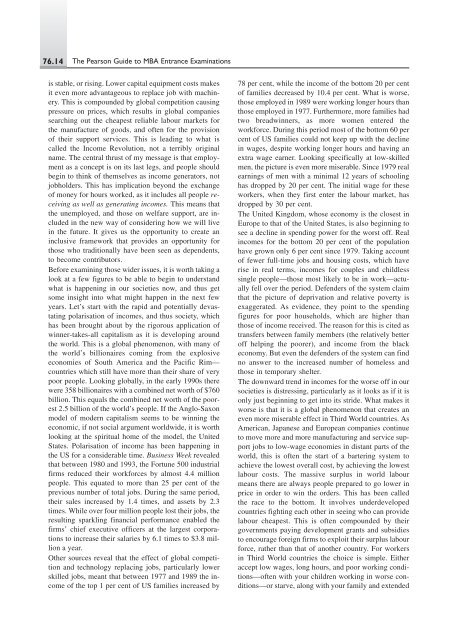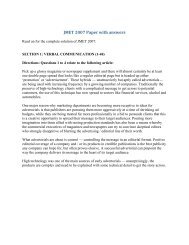Create successful ePaper yourself
Turn your PDF publications into a flip-book with our unique Google optimized e-Paper software.
76.14<br />
The Pearson Guide to MBA Entrance Examinations<br />
is stable, or rising. Lower capital equipment costs makes<br />
it even more advantageous to replace job with machinery.<br />
This is compounded by global competition causing<br />
pressure on prices, which results in global companies<br />
searching out the cheapest reliable labour markets for<br />
the manufacture of goods, and often for the provision<br />
of their support services. This is leading to what is<br />
called the Income Revolution, not a terribly original<br />
name. The central thrust of my message is that employment<br />
as a concept is on its last legs, and people should<br />
begin to think of themselves as income generators, not<br />
jobholders. This has implication beyond the exchange<br />
of money for hours worked, as it includes all people receiving<br />
as well as generating incomes. This means that<br />
the unemployed, and those on welfare support, are included<br />
in the new way of considering how we will live<br />
in the future. It gives us the opportunity to create an<br />
inclusive framework that provides an opportunity for<br />
those who traditionally have been seen as dependents,<br />
to become contributors.<br />
Before examining those wider issues, it is worth taking a<br />
look at a few figures to be able to begin to understand<br />
what is happening in our societies now, and thus get<br />
some insight into what might happen in the next few<br />
years. Let’s start with the rapid and potentially devastating<br />
polarisation of incomes, and thus society, which<br />
has been brought about by the rigorous application of<br />
winner-takes-all capitalism as it is developing around<br />
the world. This is a global phenomenon, with many of<br />
the world’s billionaires coming from the explosive<br />
economies of South America and the Pacific Rim—<br />
countries which still have more than their share of very<br />
poor people. Looking globally, in the early 1990s there<br />
were 358 billionaires with a combined net worth of $760<br />
billion. This equals the combined net worth of the poorest<br />
2.5 billion of the world’s people. If the Anglo-Saxon<br />
model of modern capitalism seems to be winning the<br />
economic, if not social argument worldwide, it is worth<br />
looking at the spiritual home of the model, the United<br />
States. Polarisation of income has been happening in<br />
the US for a considerable time. Business Week revealed<br />
that between 1980 and 1993, the Fortune 500 industrial<br />
firms reduced their workforces by almost 4.4 million<br />
people. This equated to more than 25 per cent of the<br />
previous number of total jobs. During the same period,<br />
their sales increased by 1.4 times, and assets by 2.3<br />
times. While over four million people lost their jobs, the<br />
resulting sparkling financial performance enabled the<br />
firms’ chief executive officers at the largest corporations<br />
to increase their salaries by 6.1 times to $3.8 million<br />
a year.<br />
Other sources reveal that the effect of global competition<br />
and technology replacing jobs, particularly lower<br />
skilled jobs, meant that between 1977 and 1989 the income<br />
of the top 1 per cent of US families increased by<br />
78 per cent, while the income of the bottom 20 per cent<br />
of families decreased by 10.4 per cent. What is worse,<br />
those employed in 1989 were working longer hours than<br />
those employed in 1977. Furthermore, more families had<br />
two breadwinners, as more women entered the<br />
workforce. During this period most of the bottom 60 per<br />
cent of US families could not keep up with the decline<br />
in wages, despite working longer hours and having an<br />
extra wage earner. Looking specifically at low-skilled<br />
men, the picture is even more miserable. Since 1979 real<br />
earnings of men with a minimal 12 years of schooling<br />
has dropped by 20 per cent. The initial wage for these<br />
workers, when they first enter the labour market, has<br />
dropped by 30 per cent.<br />
The United Kingdom, whose economy is the closest in<br />
Europe to that of the United States, is also beginning to<br />
see a decline in spending power for the worst off. Real<br />
incomes for the bottom 20 per cent of the population<br />
have grown only 6 per cent since 1979. Taking account<br />
of fewer full-time jobs and housing costs, which have<br />
rise in real terms, incomes for couples and childless<br />
single people—those most likely to be in work—actually<br />
fell over the period. Defenders of the system claim<br />
that the picture of deprivation and relative poverty is<br />
exaggerated. As evidence, they point to the spending<br />
figures for poor households, which are higher than<br />
those of income received. The reason for this is cited as<br />
transfers between family members (the relatively better<br />
off helping the poorer), and income from the black<br />
economy. But even the defenders of the system can find<br />
no answer to the increased number of homeless and<br />
those in temporary shelter.<br />
The downward trend in incomes for the worse off in our<br />
societies is distressing, particularly as it looks as if it is<br />
only just beginning to get into its stride. What makes it<br />
worse is that it is a global phenomenon that creates an<br />
even more miserable effect in Third World countries. As<br />
American, Japanese and European companies continue<br />
to move more and more manufacturing and service support<br />
jobs to low-wage economies in distant parts of the<br />
world, this is often the start of a bartering system to<br />
achieve the lowest overall cost, by achieving the lowest<br />
labour costs. The massive surplus in world labour<br />
means there are always people prepared to go lower in<br />
price in order to win the orders. This has been called<br />
the race to the bottom. It involves underdeveloped<br />
countries fighting each other in seeing who can provide<br />
labour cheapest. This is often compounded by their<br />
governments paying development grants and subsidies<br />
to encourage foreign firms to exploit their surplus labour<br />
force, rather than that of another country. For workers<br />
in Third World countries the choice is simple. Either<br />
accept low wages, long hours, and poor working conditions—often<br />
with your children working in worse conditions—or<br />
starve, along with your family and extended
















